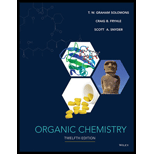
Interpretation:
The structure of cordycepin and the mechanism of conversion of its thioethyl derivative to
Concept introduction:
舧 Electrophiles are electron-deficient species, which has positive or partially positive charge. Lewis acids are electrophiles, which accept electron pair.
舧 Nucleophiles are electron-rich species, which has negative or partially negative charge. Lewis bases are nucleophiles, which donate electron pair.
舧 Substitution reaction: A reaction in which one of the hydrogen atoms of a hydrocarbon or a
舧 Elimination reaction: A reaction in which two substituent groups are detached and a double bond is formed is called elimination reaction.
舧 Addition reaction: It is the reaction in which unsaturated bonds are converted to saturated molecules by the addition of molecules.
舧 A nucleoside consists of a nucleobase (also termed as nitrogenous base) and a five-carbon sugar (either ribose or deoxyribose).
舧 A
舧 In a nucleoside, the anomeric carbon is linked through a glycosidic bond to the N9 of a purine or N1 of a pyrimidine.
舧 Examples of nucleosides include cytidine, uridine, adenosine, guanosine and thymidine.
舧 Sugar (ribose/deoxyribose) and nitrogenous bases are linked through N-glycosidic bonds.
舧 These glycosidic bonds are formed by condensation reaction of first carbon of sugar molecule with the nitrogen atom
舧 This particular glycosidic bond is stable in basic solutions, but readily hydrolyzes in the presence of acids.
舧 Cordycepin is a nucleoside containing
舧 Reductive desulfurization occurs in the presence of Raney Nickel. This results in the elimination of sulfur followed by the reduction
Want to see the full answer?
Check out a sample textbook solution
Chapter 25 Solutions
ORGANIC CHEM. VOL.1+2-W/WILEYPLUS
- Can I please get help with this.arrow_forwardDetermine if the following salt is neutral, acidic or basic. If acidic or basic, write the appropriate equilibrium equation for the acid or base that exists when the salt is dissolved in aqueous solution. If neutral, simply write only NR. Be sure to include the proper phases for all species within the reaction. N₂H₅ClO₄arrow_forwardPlease help me with identifying these.arrow_forward

 Chemistry for Today: General, Organic, and Bioche...ChemistryISBN:9781305960060Author:Spencer L. Seager, Michael R. Slabaugh, Maren S. HansenPublisher:Cengage Learning
Chemistry for Today: General, Organic, and Bioche...ChemistryISBN:9781305960060Author:Spencer L. Seager, Michael R. Slabaugh, Maren S. HansenPublisher:Cengage Learning Organic ChemistryChemistryISBN:9781305580350Author:William H. Brown, Brent L. Iverson, Eric Anslyn, Christopher S. FootePublisher:Cengage Learning
Organic ChemistryChemistryISBN:9781305580350Author:William H. Brown, Brent L. Iverson, Eric Anslyn, Christopher S. FootePublisher:Cengage Learning


